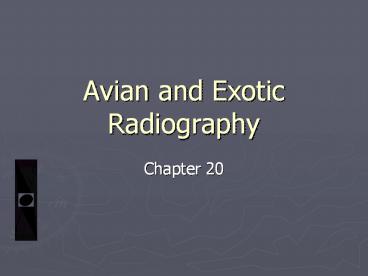Avian and Exotic Radiography - PowerPoint PPT Presentation
Title:
Avian and Exotic Radiography
Description:
Caused an increase for need of diagnostic technique and equipment. All principles for companion animal radiography can be applied to exotics and avian radiography. – PowerPoint PPT presentation
Number of Views:132
Avg rating:3.0/5.0
Title: Avian and Exotic Radiography
1
Avian and Exotic Radiography
- Chapter 20
2
Introduction
- Exotic pets have become increasingly prevalent in
last few years. - Caused an increase for need of diagnostic
technique and equipment. - All principles for companion animal radiography
can be applied to exotics and avian radiography.
3
Special Considerations
- Equipment
- Essentially same as for companion animal
radiography. - A high mA x-ray machine is generally recommended
to allow for shorter exposure times. - Maximum kVp is less important for avian and
exotic radiography than for domestic animal
radiography.
4
- Exposure Factors
- Not usually measured with caliper.
- Exposure factors are chosen according to the
species and general size of the patient. - Even with the same thickness, birds require less
exposure than reptiles.
5
- Patient Restraint
- 3 types of restraint are used for avian and
exotic patients during radiography. - 1. Manual
- Physically holding of the animal
- 2. Physical
- Involves the use of devices to aid in restraint.
- Should only be used in animals that are not prone
to self-trauma - 3. Chemical
- Sedation
- Head and torso are restrained first, then the
wings, and the legs last.
6
Avian Radiography
- Whole Body Ventrodorsal View
- Positioned on back.
- Physical restraint is preferred.
- Whole-Body Lateral View
- Placed in right lateral recumbency with wings
pulled back. - Wing-Caudocranial View
- Manual positioning is required due to awkward
position of the patient. - Bird is held upside down and body is
perpendicular to the cassette. - Gastrointestinal Contrast Study
- Same general principles as those found in
companion animals.
7
(No Transcript)
8
Rodent Radiography
- Whole-Body Dorsoventral View
- Can be placed in a positioning device
- Can secure to cassette with tape
- In rabbits and guinea pigs can be positioned the
same as a small domestic animal. - Whole-Body Lateral View
- Same as dorsoventral or that of a companion
animal.
9
(No Transcript)
10
Reptile radiography
- Turtle
- Whole-body dorsoventral view
- Turtle is turned on the back and then returned to
ventral side. Turtle will naturally extend legs
and this is when exposure should be taken. - Minimal restraint is required.
- View should include entire body.
- Whole-body lateral view
- Turtle is placed on side and attached to wood or
plastic rack. - Whole-body craniocaudal view
- X-ray beam is through front of turtle
11
- Lizard
- Whole-body dorsoventral view
- Can be secured with tape with minimal restraint.
- X-ray beam is directed vertically through the
back of the patient. - Whole body lateral view
- Placed in right lateral recumbency against the
cassette. - Snake
- Whole-body dorsoventral View
- Can be placed in cardboard or radiolucent plastic
box. - Can be placed in long radiolucent plastic tube
with ends plugged. - If radiographing in segments, then make sure to
label the segments. - Whole-body lateral view
- Can use physical or manual restraint
12
(No Transcript)
13
(No Transcript)
14
Fish Radiography
- Dorsoventral and Lateral Whole-Body view
- Can be challenging because need water to breathe.
- Can be placed in plastic bag and then placed on
top of cassette.
15
(No Transcript)

